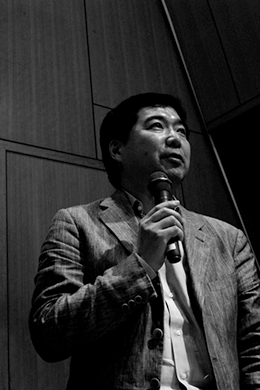Safety and Security: As Can Be Observed in Overlapping Areas
Professor Hideaki Shiroyama / Graduate School of Public Policy, University of Tokyo

“Risk and Security-Redefining the Concept and the Structure of Governance” (an exclusive seminar) was held on July 16, 2014.
While “risk and security” appeared in the title of the seminar, in actual discussions these areas have previously been mainly divided into two groups. The first group has focused mainly on engineering and has been discussing the concept of risk and “safety” that involves problems of social and technical risks, which comprises how to guarantee safety when dealing with these risks. The second group has been discussing the problem of security threats primarily in areas such as diplomacy and defense, and considered the methods needed to guarantee security in the face of these threats. To date, there has been very little discussion between these two groups; so this seminar proved to be a novel initiative.
“While safety and security were previously two different spheres, the situation has changed in recent years and, as a result, I believe there is a growing sphere in which they overlap. I first wanted to know which issues were currently changing, how they were changing and how they overlapped.” (Prof. Shiroyama)

One classic case of this “overlap” is the series of issues accompanying the Fukushima nuclear disaster. While this was originally a natural disaster risk and a safety issue related to the damage to the Tohoku region from the major earthquake and tsunami on March 11, 2011, the situation changed as time went on, resulting in an increased security focus on how the nation should respond to such states of emergency.
While “the spheres in question are starting to overlap,” the opinions and approaches to problem solving in the fields of safety and security differ. Risk researchers have stated that since both safety and security are based around risk, clarifying the characteristics of each risk, weighting them, quantifying them, and prioritizing them in terms of safety and security can form a basis of evidence at the time of making policy-related decisions. However, while political scientists agree that diverse and uncertain threats are a risk in themselves, they consider that when prioritizing such risks, decisions are most often influenced by cultural and regional traits as well as the nature of the events concerned, and are often dependent on current political situations, meaning that the factors which determine the risk weighting are inevitably volatile.
“From an engineering point of view, it is important to numerically rank and rationalize. On the other hand, from a political point of view, it is of course not that simple as it depends on the cultural and regional traits as well as the nature of the events. However, I believe that there is a good reason to include numerical assessments into political discussions. For instance, in a scenario where either 10 people will die or 10,000 people will die, it is not possible to say if one scenario is more important than the other purely based on political ways of thinking. However, it is also not possible to make these decisions based on scientific knowledge alone since it is politics that determines the basis for such decision-making. I believe that priorities can sometimes be determined by referring to the numerical evidence once the basis for the decision has been determined. In that sense, numerical data are a resource which can be used for making specific political decisions.”

Many researchers from outside the fields of safety and security also took part in the seminar. Prof. Shiroyama says that an unprecedented number of ideas and viewpoints were gained from this discussion with other fields.
“I believe it is very significant that we were able to confirm that the two groups overlapped in many areas. This was the first task. Next, I want to examine how to address each of the issues—such as how to address them conceptually and institutionally, and at regional or national levels. That is the next step.
Researchers in various fields are setting common goals to solve problems, accepting each other’s differing opinions and points of view and conducting extensive discussions and investigations, with several possibilities in mind. Perhaps this steady process alone provides the clues for making the world a better place and paves the way for the breakthroughs needed to solve various issues.
― Reference material ―
July 16, 2014 Program (Exclusive seminar)
Session – Redefining the concept of “risk” and “security”
1. Prof. Atsuo Kishimoto
Project Professor, Graduate School of Public Policy, the University of Tokyo
Title of Presentation: Mapping out the diverse use of key concepts relevant to “risk and security”
2. Prof. Kiichi Fujiwara
Professor, Graduate Schools for Law and Politics, the University of Tokyo
Title of Presentation: Origins of Threat and Security: Securitization and International Relations
3. Prof. Yee-Kuang Heng
Associate Professor, Lee Kuan Yew School of Public Policy, National University of Singapore
Title of Presentation: Risk and Anglo-American Strategic Thought
4. Prof. Taketoshi Taniguchi
Professor, Policy Alternatives Research Institute, the University of Tokyo
Title of Presentation: Institutional Challenges for Building and Maintaining A Secure and Resilient Japan
<Session – Consideration of Governance Approach>
5. Prof. Yves Tiberghien
Associate Professor, Director, Institute of Asian Research, the University of British Columbia
Title of Presentation: Governing systemic risk at the global level
6. Prof. Masahiro Sugiyama
Assistant Professor, Policy Alternatives Research Institute, the University of Tokyo
Title of Presentation: Security implications of climate change risks
